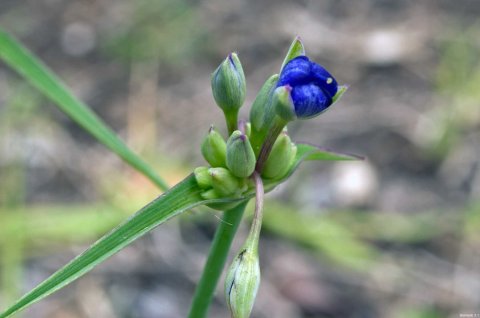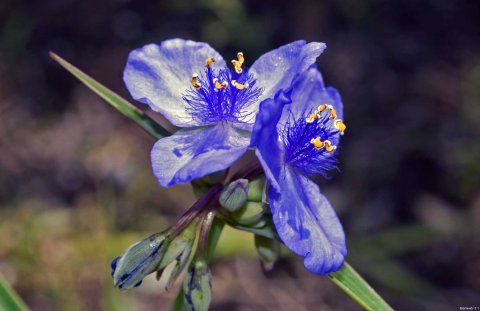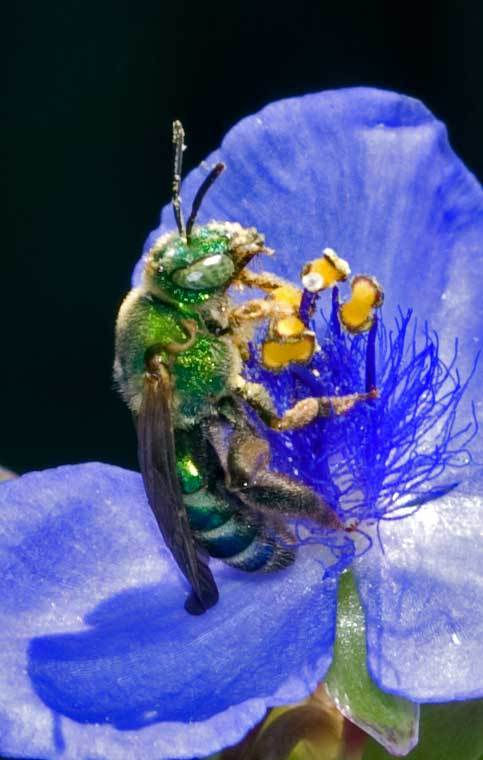Whenever you go shopping (at least, whenever I go shopping; maybe you’re different) you seem to come home with more than you set to out to get. For instance, last month I went to my favorite native plant nursery (Mesozoic Landscapes in Lake Worth) to pick up a new tree (a Bahama Strongbark to replace the White Lead Tree that volunteered in my front yard). While I was at the nursery, though, I wandered through the bitterbush (Picramnia pentandra) section and realized that I’d been wishing for that for quite some time. So I brought home a couple of those as well. What’s more, these bitterbush pots had some spiderwort volunteers growing in them! I love wildflowers, and getting them “for free” (I did have to pay for the bitterbush, after all) is the best way!
Common Spiderwort, known to gardeners as Tradescantia ohiensis, is a crafty little flower. It only blooms relatively early in the morning, so if you have to get the kids off to school, you’d better come back quick before it disappears. Last week I was a bit too slow, and she’d gone to bed:
You can see the flower petals all folded up tight inside the sepals, waiting for the morrow.
And today I was able to get home in time to catch her in full glory:
As always with native plants, I check to see what Rufino Osorio has to say. Here is his final thought about the plant:
Except for the ephemeral nature of the flowers, which last only a few hours in the morning, and its abundant self-seeding, this wildflower is nearly perfect.
I usually consider Rufino to be the last word on a subject, but here I have to wonder. “Abundant self-seeding,” hah! I had two of these at the old place, and once they tired out I never saw another one. Maybe these plants will try to restore Mr. Osorio’s reputation by seeding, at least a teensy bit.
If you look at that last picture closely, you’ll see that this plant has the potential to put out a lot of blooms; the blooms in wait look almost like rows of shark’s teeth, just waiting for their predecessors to break off so they can have their day in the sun.
This flower is attractive to all sorts of native pollinators, including our lovely halictid (sweat bee in the family Halictinae), Agapostemon splendens:
I’m hoping that if it gets enough pollination visits and enough sun/shade/water/drought, it will start to spread itself through the backyard. I’ve got enough pest species (Spanish needles, Beggarticks, etc.) that it would be nice to get some competition for them!




I just came across your blog when I was looking up spiderwort to ID whether it’s native. I’m in central NJ, zone 7, and spiderwort is growing like a weed in a flower bed by my vegetable garden — it is spreading vegetatively like a daylily and I have huge clumps. When I’ve dug up volunteers and thrown them on the compost pile, they’ve rooted. If you want me to send you some let me know — I have to clear some out to make room for other plants.
Thanks for stopping by, Jane! It sure is amazing how what looks like an innocent and pretty addition to the garden can start to look like a terrible greedy weedy, isn’t it? Hopefully the blooms will help ease the pain of the weeding duties. I just got back from a brief vacation and had a ton of weeding to do–all of it was pulling out invasive non-native plants. But at least my Florida natives thrived as well! And sorry to say, I’ll have to pass on your kind offer of sending me your New Jersey-ecotoned plants. Much as I’d like to welcome them, I’m afraid they wouldn’t thrive like the ones that are used to our zone 10B. Cheers!
6/4/13
I just found out what these are, by doing this Google search. And I’m in Western Massachusetts! I saw maybe three last year. And the lawn-mowing guy mowed them down. I thought, oh that’s too bad. But this year they are back and “invading” the lawn! (the lawn mowing guy doesn’t come very often—cheap landlord.) I’m convinced they are spreading underground. Might be a new invasive fellow! It’s 12:45 PM right now, and the biggest plant, that was blooming yesterday, is in full BEAUTY of “the color purple!!” Wow!! But invasive invalidates beauty, as we know from Bittersweet. Indeed a bittersweet presence, as it attacks everything in sight (don’t stand next to it too long!)
So, because I hadn’t yet read of this plant being here in New England, I thought I’d post!